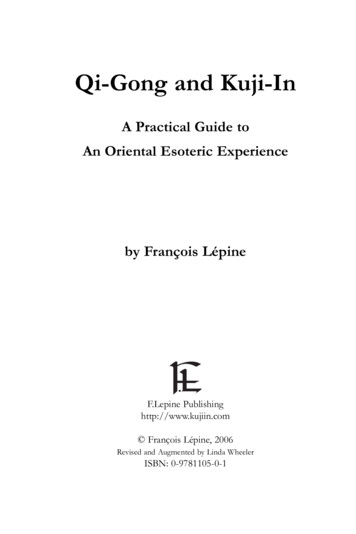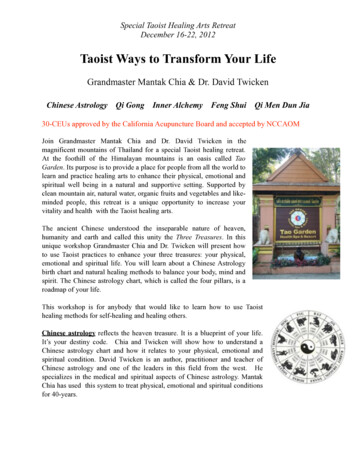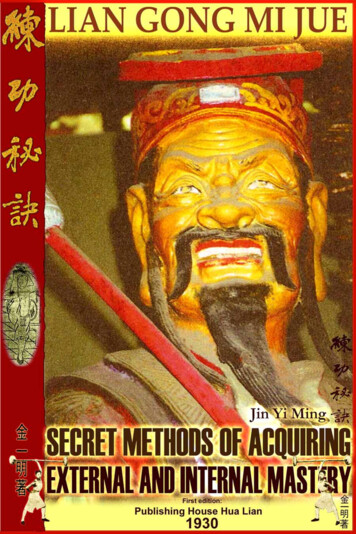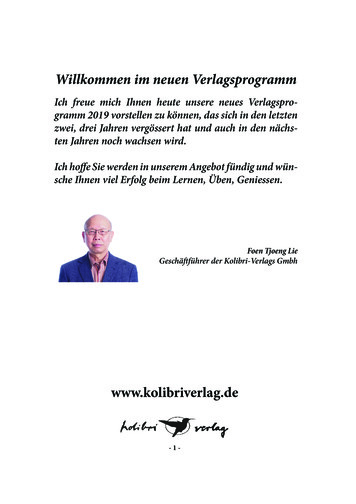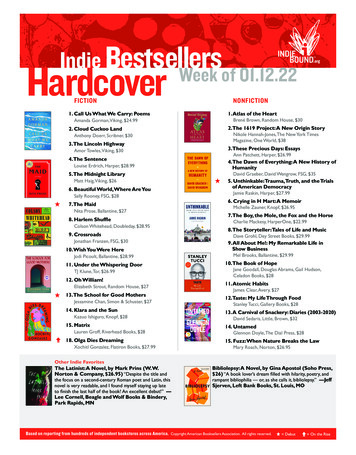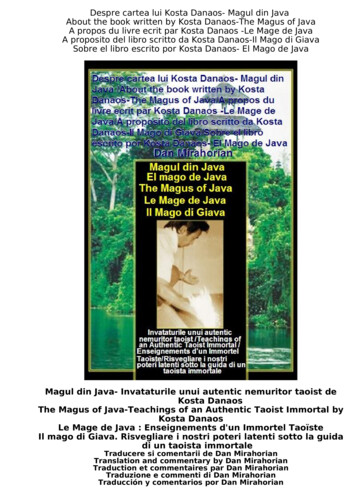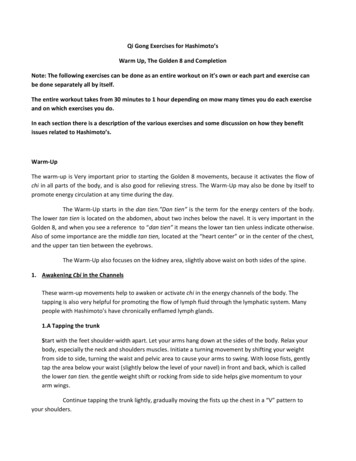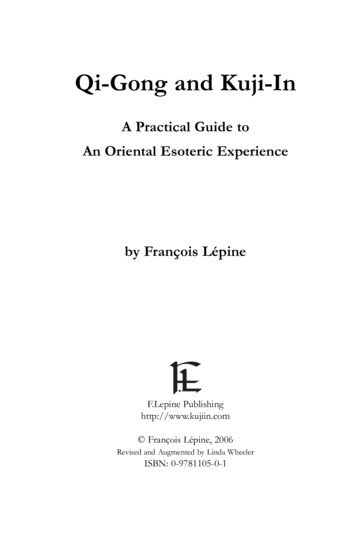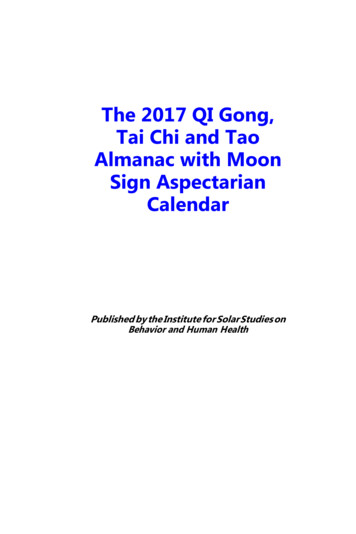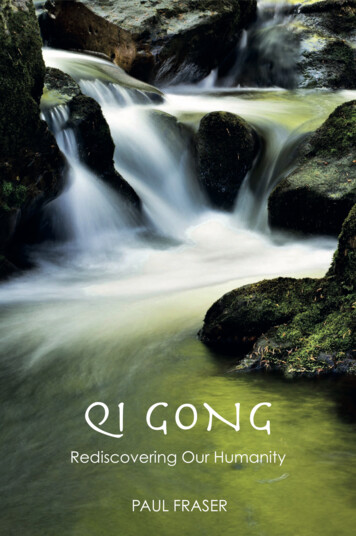
Transcription
QI GONG
QI GONGRediscoveringOur HumanityPaul Fraser
First published in 2019 byAeon Books Ltd12 New College ParadeFinchley RoadLondon NW3 5EPCopyright 2019 by Paul FraserThe right of Paul Fraser to be identified as the author of this work has beenasserted in accordance with §§ 77 and 78 of the Copyright Design and PatentsAct 1988.All rights reserved. No part of this publication may be reproduced, stored ina retrieval system, or transmitted, in any form or by any means, electronic,mechanical, photocopying, recording, or otherwise, without the prior writtenpermission of the publisher.British Library Cataloguing in Publication DataA C.I.P. for this book is available from the British LibraryISBN-13: 978-1-91280-706-2Typeset by Medlar Publishing Solutions Pvt Ltd, IndiaPrinted in Great Britainwww.aeonbooks.co.uk
ForAnisha,A True Partner in Love, LifeandThis Path We Share
NPART ONELife as an exchange with the universe3What do we cultivate and how is it cultivated?13Essentials of practice29Qigong, history and our present age43Energy and archetypes69PART TWOThree practices83vii
viiiCONTENTSWaigong practice: external Yi Jin Jing(“Tendon Changing Practice”)85Moving neigong: Tai Qi Dao Yin practice101Neigong: Zhan ZhuangCheng Bao (“Tree Hugging”)119
AcknowledgementsThe help, guidance, and encouragement I’ve received has beenmuch and from many people. I would like to mention a few ofthem here, knowing that the depth of my gratitude is beyond anywords I can find.Master Ou, Wen Wei. The best teacher and example I have ever had.Mandy Ou for treating us all like family and being a mother to us all.Olivia Ou for tirelessly arranging events and acting as an interpreter,facilitator and good friend.Sing Yu for your friendship, great example, and photography skills.Adam Sommer of the “Holes to Heavens” podcast, gifted astrologer,good friend, and the catalyst for this book.Tom Tam, for saving my life, being my first teacher, and introducingme to a world I had no idea existed.Master Vincent (Fong) Chu of the Gin Soon Tai Chi Federation, whoseTai Qi skills are only matched by his generosity in teaching.Sifu Dimitri Mougdis of The Internal Arts Institute of Stuart, Florida,a brilliant Tai Qi instructor with tremendous warmth and humor.Closer to home: My wife, Anisha Desai Fraser for your love, patience,and thoughtful feedback, and our dog, Jade, great sage of unconditionallove.ix
Preface“[C]oincidence exists in necessity. Without necessity, no coincidence. How could necessity come into being if there were nocoincidence? Many coincidences make a necessity.”—The Path of Life, Vol. III, Translated English Edition 2003Ou, Wen Wei, Qigong MasterI dismissed those words at first; I found them confusing. Later, I tried tomake sense of them, eventually coming to the realization that every pivotal moment I could recall came about through coincidence. It seemedas if there had been some guiding force that appeared, random in themoment, but, in hindsight, fitting a discernible pattern.As human beings I suppose most of us strive to make meaning fromthe events of our lives. It is understandable. Our lives are all we have.They are important to us. Why would we not seek to make what occurswithin them matter? In the end it may make no difference if there is aguiding presence or not, as long as we value what we do and do whatwe value.Looking back, I may have been one of the least likely candidates forexploring the art and science of qigong. Everything about my knowledge and experience was conventional and, at best, average. But then axi
xiiP R E FA C Every unconventional illness presented itself and the average avenues oftreatment were not enough. Through a series of coincidences, I foundmyself at first helped and then later transformed by qigong.Adding to those coincidences, the place I lived at the time, Boston,Massachusetts, was home to tremendous talent when it came to qigong.There was Tom Tam, my first teacher and the man I credit with saving my life; Dr. Yang, Jwing-Ming of Yang’s Martial Arts Association,scholar and author of numerous books on the subject; Master Vincent(Fong) Chu of the Gin Soon Tai Chi Federation; Lin, Soong of the Linfamily (Wild Goose Qigong), famous for generations as qigong practitioners, who once, using only qi, repositioned a herniated disc in mylumbar; and Daoist Priest Zhou, Xuan-Yun, who grew up on WudangMountain mastering medicine, all of the Wudang martial systems, andDaoist ritual—just to name a few. I found myself in great need andencountered much greater talent and ability.In another work, Pangu Mystical Qigong, Master Ou describes the purpose of human evolution as harmony of heaven, earth and humanity.We are part of a vast network of Life, bridged by qi and spirit. Trackingour evolution may be viewed through three key stages: “[material, circumstances and people are] coexisting relatively [antagonistic], tolerating each other then becoming stable, being harmonious then resonant.”My study of qigong followed this pattern. I went from illness (coexisting antagonism), to learning, practice and health (tolerance and stability) and on to endless fascination (harmonious and resonant). In theprocess I found a way of living that continues to offer value and meaning, made the best friends anyone could hope for, experienced deeplove in many forms, and have known the incomparable joy of helpingothers.The debt I feel I owe to my teachers, to those who kept this priceless body of knowledge alive, is, I’m afraid, well beyond my capacityto repay, despite their insistence that there is no such debt. I have theirexamples of hard work, generosity and kindness. They make me wantto try, despite myself, to offer just a fraction of what they give, hoping,in some way, to honor those gifts.Paul FraserAsheville, North Carolina, USA
IntroductionInitiations“It was involuntary. They sank my boat.”— John F. KennedyLike many nineteen year-olds, I had a vision of how my life wouldunfold. At the time, mine had something to do with investment banking, homes throughout the world, and, in later years, a Pulitzer Prize.That vision changed abruptly, coming from another vision in a hospital bed.Six years earlier, at thirteen, I had a respiratory illness that developedinto pneumonia. In the course of a chest x-ray a strange shadow was,quite by accident, seen by a passing orthopedic surgeon as anomalies inparts of my skeleton. He mentioned it to the radiologist, who reportedit to my pediatrician, who then consulted with that same orthopedicsurgeon.It was an extremely rare bone disease. It was a type of growth thatinfiltrated the bones on either the right or left side of the body. Generally it was nothing to worry about, and would remain for one’s entirelife undetected, but, in my case, it was strangely active. It had all butxiii
xivINTRODUCTIONdestroyed a section of my right humerus (the upper arm). A fall, or evenexcessive pressure would most likely result in a break. Further scansnoted similar growths of a more benign nature in my ribs, two fingers,and the right side of my pelvis. Surgery was scheduled within the nextcouple of months and my right humerus was reconstructed with bonetaken from my left hip. After physical therapy I was cleared to resumemy normal, awkward teenage years. I would, however, need to havethe growths in the ribs, fingers, and pelvis checked every six months orso. Once I stopped growing there would no further need for concern.I began university studies at eighteen. All seemed well as I tookon the full course load of a Finance major, made new friends, took upintramural martial arts, and explored the many diversions Boston hadto offer. In the middle of my sophomore year it was time for anotherbone scan, most likely to be my last since I had stopped growing, thistime using what was then the relatively new technology of MagneticResonance Imaging. The results had always shown no change in activity of the growths; there was no reason to suspect anything else.The results of what was to be my last scan were very different andvery unusual. The growth in the pelvis had become so active that muchof my iliac crest was affected. The change had been so dramatic over thepast six months it was very possible the growth had become malignant.Immediate surgery was scheduled to remove the growth, have it biopsied, and repair the pelvis with another bone graft.That surgery was much longer and more involved than the previousone. When I awoke from the anesthesia there was a great deal morepain. I was grateful for the morphine and became acutely aware of itsabsence every four hours. When the surgeon told me that the biopsyshowed cancer activity, the fear, pain, and opiate effects of the morphinemixed together, producing a kind of vague, disbelieving disassociation.We would talk about it later, he said, perhaps after my family arrivedand I was feeling a little stronger.There wasn’t much more to say, it turned out. The tumor, about thesize of a softball, had been removed. It was such a rare disease that noblood tests had yet been developed to track its activity. All we could dowas continue to watch and wait. And hope.I lay there with my right leg attached to a traction device, a draininserted into the incision to remove debris from the surgery, withuneaten green jello on a nearby tray, staring at the ceiling, trying not
INTRODUCTIONxvto worry, counting the minutes to the next morphine injection, as thepain ebbed its way back. There was a crash of metal on floor as something was dropped outside my hospital room. The vibration from thecrash sent new waves of pain through my pelvis. I closed my eyesand exhaled. My heart was beating fast, from pain, being startled, andworry that my life could end much sooner than I expected. I glanced atthe clock. Twenty minutes to go until morphine.It wasn’t sleep but I felt strangely relaxed and heavy. My heartslowed, my breathing evened out as the pain seemed to lessen witheach exhalation. Behind my eyelids images of tiny squares covered myfield of vision. Gradually the squares formed an intricate pattern ofwhat appeared to be colorful tiles—a mosaic. I could no longer feel anyspecific part of my body, only a sense of one part of me sinking heavilyand another floating lightly, gazing down at the mosaic.The field of vision closed in to a small grouping of colorful tiles, different shades of sky blue and cloud white. My attention went to oneblue tile in particular. It seemed to become brighter, outlined with alight shimmer of gold light. A hand appeared and pointed to the tile.There were no audible words, just a strong sense of “this tile is you.”The visual field broadened, showing several hundred surroundingtiles. Two fingers of the hand plucked the tile that was me from themosaic. As the tile was plucked, about two thirds of the surroundingtiles fell away. The tile was placed back. All the tiles that had fallenaway repositioned themselves in their original places, with the entiresection of the mosaic outlined in that same golden shimmer of light.“This is why you won’t die,” I felt. With that, a strong wave-like feelingpassed through my body and I was abruptly awake.But different.The first noticeable sensation was actually the absence of one: I feltno pain. I was calm, happy, with a sense of eagerly anticipating somestroke of good fortune. The hospital room was the same, yet I sensed avibrancy to my surroundings I’d never experienced before.A nurse walked in and smiled, asking if I was ready for a dose ofmorphine. “No, thank you,” I said, “I feel fine. I’ll wait for a while untilI really need it.” Was I sure? I was. Did I know it was always a goodidea to be medicated ahead of the pain, that it was the best way to keepit managed? I did. I remembered us talking about that. “Thank you forcaring so much.” I felt tears come to my eyes. I could feel something
xviINTRODUCTIONabout her. She had genuine compassion. It made her happy to take careof people. She had always been like that since she could remember.How did I know that? Did I know that? Was I just creating a story?Hours passed. I didn’t surf through television channels, try to readanything or have any desire to direct my attention to anything otherthan my own sense of being. It was comfortable and interesting justbeing. I was pleasantly surprised. I had never felt like that before.I had always needed some way of occupying myself, even when I ate:I wanted something to read, to watch, someone to talk with.I was offered more pain medication. I would need it, she said. Laterin the day she would try to stand me up, perhaps take a few steps oreven try some crutches. These actions were often painful, at first, rightafter surgery. That sounded great. I was ready. I wouldn’t need themedication. I was doing well without it. Was I being honest with herand, more importantly, with myself? I was. She sighed. “All right,” shesaid dubiously, “we’ll try.”Standing and walking with crutches wasn’t nearly as problematic asthe group of one doctor, a physical therapist, and two nurses, all waiting to catch me, seemed to suggest. I moved down the hallway. “Practicing,” I said, to kind admonishment. I ought not to rush things, theytold me, and I certainly should not fall.After two days I was left to my own devices. I could get up and roamthe halls on crutches whenever I liked. I passed one of the other hospitalrooms. It was filled with people, family for a woman who had beenseverely injured somehow. She was in a large traction device that heldmost of her body in place and rotated, automatically, on an even largerwheel, periodically. There was a small girl in the room, perhaps fiveor six years old. Her daughter. No one seemed to be paying attentionto her. She was very frightened. She stepped out of the room and satdown on the floor in the hallway with silent tears streaming down herface. We looked at each other. I could feel her being afraid, sad, her lovefor her mother, her confusion, her desire to be both close to her motherand far, very far, from this place. It rushed through me and, for a splitsecond, I was sure I would break the rule of not falling. I offered what Iam sure was a weak smile. She smiled back, then was led back into theroom by someone who had realized she wasn’t there.I returned to my room and cried.Two more days passed and the feeling of being deeply connectedwith people, places, circumstances and with myself was gradually
INTRODUCTIONxviislipping away. I felt panic. I tried to hold onto the connected feeling,but the more I tried the more quickly it would dissipate. In its place Icould feel worry, uncertainty, and more anxiety than before. The painreturned and, once again, I happily accepted medication.I was sent home with detailed instructions for my own rehabilitation. I was young and this wouldn’t be a problem. I would regain mystrength in no time. After all, look how well I had been doing.Except that I wasn’t doing well. My blood pressure shot up to a levelthat was considered just below dangerous. Whenever I ate I had difficulty keeping the food down. I wasn’t sleeping, was anxious almostconstantly. With post-operative check-ups it was determined that thebone was not filling in the pelvis. I wasn’t healing. The physicians, myfamily, and a few friends were sure this was some kind of post-traumaticstress. I should talk with someone; a therapist or perhaps a priest.I was sure that talking wouldn’t help. The sensations, even theanxiety, felt more in my body than my mind. Besides, I thought, howcould I explain my experiences in the hospital? Would anyone believeor understand? For all the good people I had in my life, the mysticalwasn’t something they were likely to embrace. It wasn’t how we lived.I went to a library and searched for books related to mystical experiences. All I could find (this was 1987, after all) were books that describedvisions and occurrences that were far more elaborate and long-lastingthan mine.My physical condition was going from bad to worse. I was rapidlylosing weight, signs of sleep deprivation were clearly apparent, myblood pressure stayed high enough that there was talk of medication,and the condition of the pelvis was unchanged. I felt very weak andwas sure I was dying. I began avoiding family and friends, unable tomeet worried looks and offers of advice I could not take.On my way to yet another library, I stood, supported by crutches, onthe subway platform at Wollaston station. Idly I glanced up, and saw asign that was written half in English and half in Chinese characters: LeaTam Acupuncture Center. After the words passed through my mind I feltthe same wave-like sensation that brought me out of my reverie in thehospital. Suddenly, I felt infused with a sense of calm and confidence.The train came and went as I stood there staring at the sign, afraid tomove, thinking that, if I did, this blissful feeling would be gone.Twenty minutes passed as I stood, unmoving.To hell with it. I’m going over there.
xviiiINTRODUCTIONTom Tam sat behind a desk in the waiting room. He greeted me andasked why I was there. I unloaded, not even thinking that English wasn’this original language, that I ought to slow down, and that he may onlyhave been getting about every third word. I barely paused to breathe asI recounted the details of the strange illness, the more unusual occurrence of it becoming malignant, the downward spiral I was experiencing post-surgery, culminating with one question: Can you help me?He smiled and answered, “Yes”. How could he be so sure? I blurted.“It’s my job to know,” he explained, “and anyway, I can treat you and,if you don’t feel better, don’t pay me.”Well, there’s confidence, for you, I thought, then explained that, evenif I felt better, I couldn’t pay him since I hadn’t planned on coming inand all I was carrying were two subway tokens and a library card.He held eye contact for a few seconds and smiled. “It’s OK. You’ll comeback. You keep your word. Now, would you like to try acupuncture?”I would. And did. He helped me onto a treatment table and insertedthe needles in my back, legs, and arms. After asking if I was OK so far,he made circular motions with his hands over the needles. The wavelike sensations began again. I drifted into a state that was neither asleepnor awake. I could feel tension, pain, stomach discomfort, pressure inmy head I hadn’t noticed before: all seemed to lift to the surface andbe carried away down my back, through my legs, and out of my body.I fell asleep.I awoke to Tom removing the needles and asking me how I wasdoing. I looked at the clock. It had been thirty-five minutes since I gotonto the table. He helped me up and I stood, unaided, feeling as if Iwere standing straight for the first time in about six weeks. The insideof my body felt substantial in way I had almost forgotten. After about aminute I felt my physical structure pull me down into a familiar slouch.Tom had been watching and explained that it was a good sign. Theqi—did I know what qi was? Not really? Well, the qi, or energy in mybody had begun to enter the injured and imbalanced places. As it didso, I would heal much more quickly. My body couldn’t yet sustain afully upright position because my structure would need time to repairitself. The qi was already in place, which was why I felt normal for afew seconds.May I come back tomorrow? “Best to wait a couple of days to letthe qi do its work,” he explained. We made another appointment and I
INTRODUCTIONxixcontinued on to the library and took out the only book on acupunctureI could find, reading it twice before I saw him again.At our next meeting I showed him the book and, with a nineteenyear-old’s lack of humility, proceeded to explain to him what he did fora living. He smiled. Much of what was in the book was accurate, butthere was a great deal that wasn’t. Take, for example, causes of disease.It is much more complicated than what was explained in only a fewsentences.Tom’s explanation went something like this.Since energetic factors are key elements in our healing processes,it stands to reason that, when these factors become imbalanced, theybecome the causes for disease and disharmony.Many diseases and disorders have obvious causes. Someone sneezeson you in line at the grocery store and, hours later, you have a scratchythroat. Maybe the food you had at your favorite take-out place wasn’tcooked as well as it should have been and now you’re experiencinggastric distress. Or perhaps you have been exposed to a harmful or toxicsubstance and are now experiencing signs of being poisoned. These areobvious.But many illness are not so obvious. No one is really sure why aperson’s immune system doesn’t identify mutated cells in his body thatlater become malignant and multiply into cancerous tumors, especiallywhen this person has lived a fairly healthy and responsible lifestyle.The causes for diseases of the nervous system such as Multiple Sclerosisand Lou Gherig’s Disease have baffled researchers since their discovery.Genetic research shows the presence of inherited genes that may “activate” in some people and create disease, but no one really knows whythese genes activate in some people and remain dormant in others. Justas baffling is why some people never seem to get sick and others seemto contract everything.From an energetic point of view, disease can be viewed as energy thatis disharmonious to the overall health and well-being of a person. Thisenergy can be introduced through obvious means, such as a sneeze orcontaminated food. Or through more subtle ways.Suppose you’re driving to work during rush hour and it’s a particularly bad day for traffic. Other motorists are just as eager, and, therefore,anxious, to get to their destinations. No one has time to spare. Peopleare being cut off, honking, yelling, and generally behaving in ways that
xxINTRODUCTIONcreate distress. Once you get to work, you’re already in a heightenedstate of anxiety, only to find out that something has gone wrong, yourfull workload is about to get even heavier, and everyone seems angry.You have too much to do, and so are unable to take a break. Lunch mustbe delivered to your desk. You eat and work. As you are eating, yourstress and that of those around you becomes part of your lunch.When your work day ends (later than usual) you go home to findthat your significant other has had an equally bad day. Of course, youmay not be your most balanced and understanding self; there was thehorrible traffic, the greasy, undigested lunch, and long working day.Either you or your significant other says something that gets misinterpreted and perhaps an argument begins. The tension continues throughdinner. Both of you may have the good sense not to argue and eat,but intuitively you know you are also absorbing the energetic circumstances of the meal.Still, the meal isn’t pleasant or relaxing, and you’re thinking thatyou’d like to have at least one pleasant sensation today, so you havebowl of ice-cream to fill the void.You end the day by watching television. A comedy to cheer you up.But the comedy keeps being interrupted by commercial messages thatgive you the unconscious impression that you won’t be happy unlessyou spend more than you can afford on things you do not need, whichmay have been part of the reasoning you picked that high-stress job inthe first place.Tom paused.When you think about disease and an unusually stressful day, howdoes your body feel? Pleasant or uncomfortable? The tightening inyour chest and stomach are reactions to disharmonious energy. You’reclosing down to the flow of energy because, at the moment, the energyyou’re taking in isn’t good for you. Now, if you replayed your stressful days, giving them focus, attention and energy, you’d be amplifying their effects. You’d be interrupting the qi-flow through your body,since you’ve closed down, as a defense, to what feels negative. You’veabsorbed harmful energy from stressful circumstances and your reactions to them. Then you’ve cut yourself off from the healthy flow ofuniversal energy while trying to defend against them. Then you’veamplified the disharmony within your body by giving it attention,focus, and energy.Many people live this way for a long time and manage to stay reasonably healthy. Until they don’t.
INTRODUCTIONxxiThese stresses have frequencies. They can create illness in the bodyif amplified or left stagnant in your energetic structure. Then theyaccumulate.Energy attracts similar energy. It’s all magnetic. This will serve tocreate a disease or to activate a disease that is lying dormant. If grief sitsfor a long time in a body it can weaken the lungs. If similar weakeningfrequencies are added to that grief it can create an illness. These frequencies can be induced from substances, day-to-day stress, traumaticexperiences, or they may even be passed on from parents to children,since they share an energetic structure as well as DNA. If that energybecomes so strong that it becomes a dominating force within the lungs,the cells may mutate so that they can survive in that energy. This isoften the case with cancer, he explained.Solving the problem means breaking the cycle. Strengthening qi willgive you the energy to deal with stress better and will add power toimmunity. It acts as insulation as it clears out disharmonies alreadymoving through your energetic structure.Becoming calmer, you react less. This new focus turns to that whichis healthy and life-promoting. Since similar energy attracts a similarenergy, you will gradually build up a strong reserve of healthy qi. Overtime you’ll be vital, balanced, happy, and peaceful.It made sense. I thought for a moment, and then continued myinterrogation.What about him waving his hands over me and the sensations I feltand how quickly I felt better once he started to do that?That was Fa Gong, emitting qi to help someone heal.How had he done it? Can anyone learn it? Do you have to be special?You don’t have to be special, he explained, just alive. First, I wouldhave to learn to exercise the qi to make it strong, to heal myself, to makesure that the cancer would not return. Then it would be easy enough tolearn to emit qi to help other people.So, where do I sign up? How do we do this?He wrote down an address. He’d see me Sunday morning at 8am.I should be on time.I was early.He began by teaching the Tai Qi Dao Yin qigong form without anypreliminary explanation. It was best to feel first and know later, he said.I didn’t feel anything. I was disappointed and thought I just didn’t havewhatever the knack was. That wasn’t it, he said. I’d likely not feel muchin the beginning because my body was weak. Most beginners feel qi
xxiiINTRODUCTIONalong the surface of their skin before sensing it more deeply in theirorgans and structures. My qi wasn’t rising to the surface of my body; itwas needed in my organs, my blood, and especially my bone marrow,places deeper than most of my sensory nerves. Keep doing the movements. You will feel something. You’re alive.It took five and a half weeks of daily, sometimes twice daily, practice, before I started to feel the tingling and warm sensations that manypeople report when first feeling qi. It happened to coincide with acheck-up at the hospital.My blood pressure was normal, the bone was filling in nicely. I hadregained a little weight and, while we were on the subject, I reported Ihad been sleeping better too. The scans showed no advancing activityof any of the growths anywhere in my body. All good signs.I went straight to see Tom and told him. He was happy but not at allsurprised. Keep practicing, he said.I did, and became something of pest. Whenever I had free time Iasked lots of questions. Most he answered, some he ignored, and forsome he directed me to ways of finding the answers myself.I went back to finish a university degree, seeing Tom on the occasional weekend and break. He taught, advised, and subtly influenced.Slowly I came to the conclusion that there was nothing as interesting tome than qi and how it worked.After graduation I got a job at a financial institution but otherwisethrew myself into qigong training, Chinese medical theory, and asmuch of the philosophy connected with it that I could find in English.Eventually, we went to China (1992), so that I could be introduced toand learn from one of Tom’s teachers. We learned what we could frompeople Tom was connected with, went on to Hong Kong, and, a yearlater, were off to Taiwan on a similar expedition.Boston, as it turned out, offered a great deal in the way of qigongtraining. It had a vibrant Chinatown and many generous people willing to teach (unlike the rivalries I would hear of and, later, experience).It was like a 1920s Paris of qigong.Training consisted of long periods of repetition punctuated bymoments of breakthrough. For me, the challenge was holding focus andintent while things seemed to be staying status quo. I would repeatedlydiscover that, even though it seemed as though nothing significant washappening, my sensations told me qi was flowing and condensing and
INTRODUCTIONxxiiimy experience told me that once the flow and volume reached criticalmass another threshold would be crossed.I would make this my life. I enrolled in acupuncture school.I would discover that Tom Tam was unlike most qigong masters. Hedid not cling to traditions. He insisted on having reasons for all he didand did not do. His way was to question and test everything. He wasopen to learning what he could from whomever was willing to teach,and encouraged his students to do the same. Rather than being possessive of his knowledge and students, he encouraged all of us to sharewhat we had learned, to question it, refine it, and seek knowledge frommany sources.It was most likely his example that engendered a sense of restlessness regarding my own knowl
Tai Qi skills are only matched by his generosity in teaching. Sifu Dimitri Mougdis of The Internal Arts Institute of Stuart, Florida, a brilliant Tai Qi instructor with tremendous warmth and humor. Closer to home: My wife, Anisha Desai Fraser for your love, patience, and thoughtful feedb
